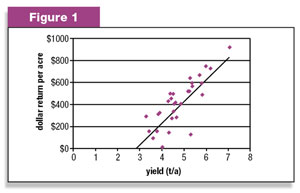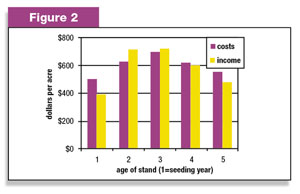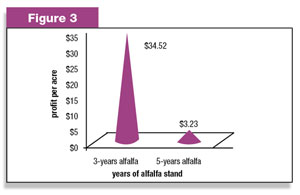Editor’s note: Even though the discussion in this article is based on an older study and prices may not accurately reflect today’s market, the general application principle of shorter rotations are still applicable for production and profitability now.
Shorter rotations mean greater profit per acre for the entire farm because of higher alfalfa yield, higher forage quality, reduced pesticide use, greater nitrogen credits and increased corn yields.
Annual yield has the largest impact on its profitability because inputs, including harvesting costs, change little as yield increases.
 This is shown clearly in Figure 1 where on-farm measurements of alfalfa yield and inputs showed that yield was the single-most important factor determining profit.
This is shown clearly in Figure 1 where on-farm measurements of alfalfa yield and inputs showed that yield was the single-most important factor determining profit.
The relationship is so strong that farmers should do all they can to remain in the high-yield range with their alfalfa.
One of the challenges to alfalfa profitability is declining yield as the stand ages.
The declining yield is due to environmental stresses, wheel traffic and diseases that appear as the stand ages.
Average yield decline of alfalfa in the Midwest is 17 percent in the third production year and 34 percent in the fourth production year.
Alfalfa yield decline with advancing age means farmers should consider turning over stands faster to stay
in a high-yield range.
We analyzed the economic value of short-term alfalfa rotations compared to long-term rotations on an average dairy farm.
The comparison is for the whole-farm crop production and the results expressed on an average profit per acre.
We analyzed for a farm with 350 acres of cropland (160 acres of alfalfa) and either three-year or five-year alfalfa stands (including the establishment year). We used approximately Wisconsin state average yields, assuming the following:
• 160 acres of alfalfa
• new seeding, 2.48 tons per acre yield at $158.62 per ton of dry matter
• established stand, 4.5 tons per acre yield at $158.62 per tons dry matter
• 85 acres corn for grain, 155 bushels per acre at $4.18 per bushel
• 105 acres of corn silage, 7 tons dry matter per acre at $102.34 per tons dry matter
The economic analysis included costs of all fixed and variable inputs.
 Figure 2 shows the costs and returns for each year of alfalfa.
Figure 2 shows the costs and returns for each year of alfalfa.
The first thing to note is that average results result in close to break even regarding expenses and income.
Secondly, seeding year yield was figured to be 55 percent of the first production year.
Anything to increase yield in this year is extremely beneficial to overall profit.
Alfalfa is profitable in the second and third years. After that, yield declines faster than costs and net losses occur. Note that in all cases, higher yields would increase profits with little increase in costs.
Equally as important, alfalfa increases profit of other crops in the rotation. Corn after corn loses money due to high nitrogen fertilizer costs.
On the other hand, following alfalfa, corn production usually results in a profit because there is no need for nitrogen fertilizer (other than starter) and because corn yields 10 to 15 percent more following alfalfa compared to corn following corn.
 Figure 3 takes the above factors into account and shows the impact of shorter alfalfa rotations on total farm profitability.
Figure 3 takes the above factors into account and shows the impact of shorter alfalfa rotations on total farm profitability.
Due to higher yields of both alfalfa and corn, as well as reduced nitrogen fertilizer costs, farm profitability has increased for every acre of the farm with shorter alfalfa stand life.
While actual numbers will vary on individual farms, depending on their yields and costs of inputs, the above principles pertain to all farms. All will see improved profitability from shorter rotations.
— Excerpts from the University of Wisconsin Extension website










